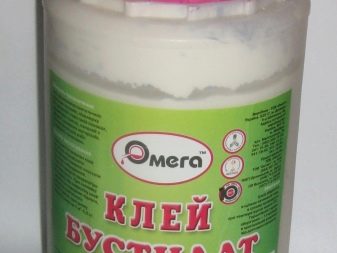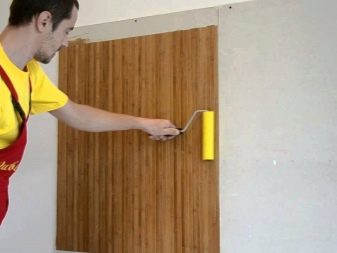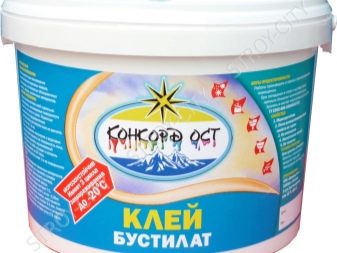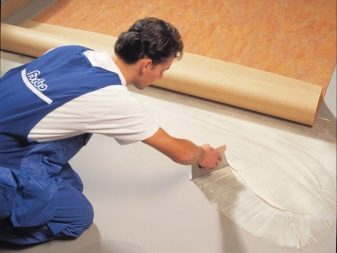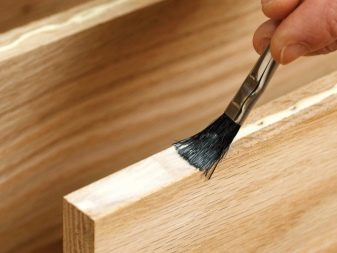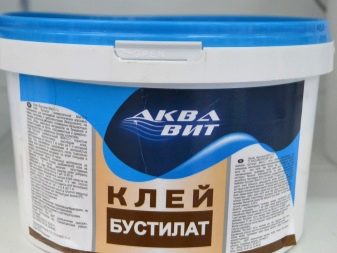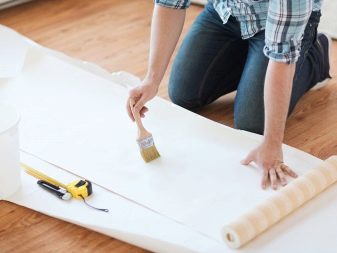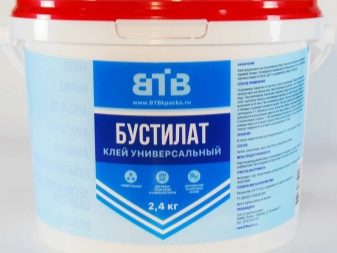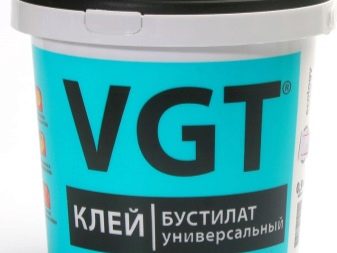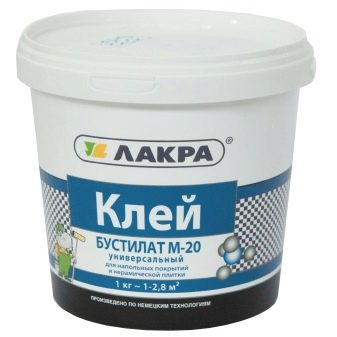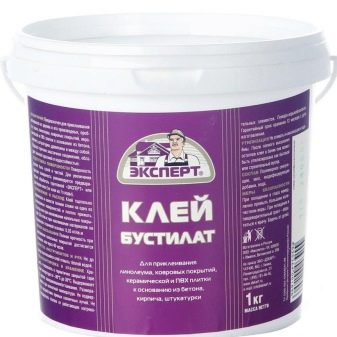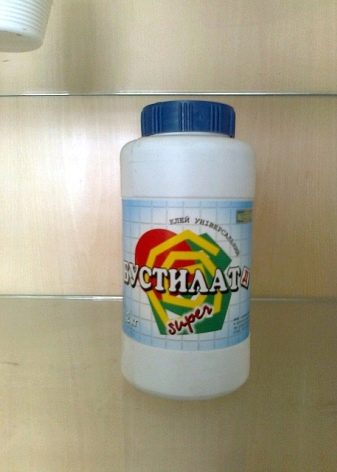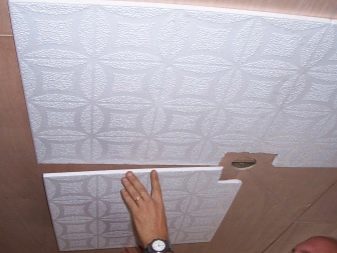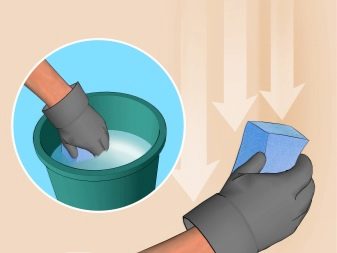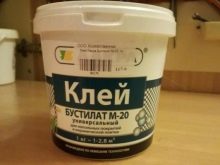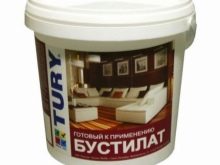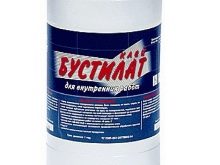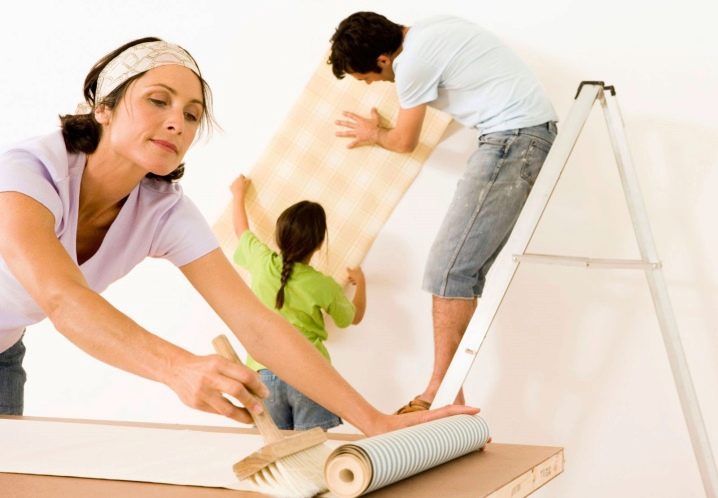Glue "Bustilat": properties and applications
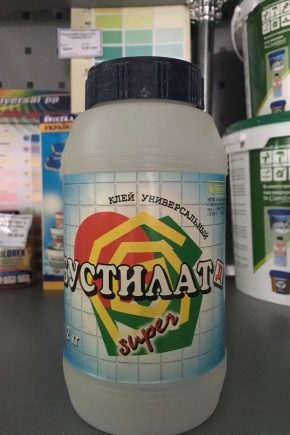
The name "Bustilat" was well known to residents of the Soviet Union. One of the most famous adhesives in the USSR for more than half a century of its existence has seen a lot of repairs, where it can be used to perform various types of work: laying linoleum, laying tile or pasting wallpaper. In the 90s, the Russian market was overwhelmed by a wave of domestic and imported adhesive products, which led to a significant decrease in demand for Bustilat and the loss of its leadership positions. But since interest in this glue remained, the manufacturing companies continued and continue to include it in the product lines.Let us find out what caused the long-term popularity of Bustilat, as well as its operational properties, advantages and disadvantages, and nuances of use.
What it is?
The popular synthetic adhesive compound “Bustilat” was developed more than half a century ago by employees of the Moscow Construction Research Institute. It is a one-component creamy mass with a latex binder base, the addition of chalk, water, carboxyl methylcellulose (CMC), which serves as a thickener, and modifying additives to give the final product optimal properties.
In accordance with GOST, its composition does not contain alcohol, toxic impurities and volatile compounds that are harmful to human health. Most often, the choice in favor of “Bustilat” is made precisely because of its safe composition, which is important to consider when carrying out interior decorating activities.
In the process of repairing or finishing, situations often arise when the use of nails, self-tapping screws or construction brackets is unacceptable for some reason. In these cases, adhesive mixtures are able to help, which can fix various materials among themselves and attach decorative elements to different types of bases without disturbing the integrity of the materials being joined.Of particular value are adhesives of universal purpose, which are equally well cope with the combination of wallpaper, flooring, tiles and decor. In addition to the widespread emulsion of polyvinyl acetate (PVA), such abilities are also inherent in "Bustilat", which has proven itself in linoleum flooring.
The product is indispensable for fixing:
- synthetic nap coverings;
- ceramic tiles;
- linoleum tile (PVC tiles);
- linoleum coatings on felt or textile base;
- Relina - two-layer wear-resistant linoleum from rubber;
- parquet and floorboard;
- carpet;
- wallpaper;
- decorative elements of wood;
- asbestos cement products.
The high performance properties of Bustilat provide an opportunity compounds of the listed finishing materials with the following types of surfaces:
- stone;
- concrete;
- brick;
- wooden;
- drywall;
- from DVP / DSP / DSP plates.
In addition, "Bustilat" allowed to mount the decor on plaster bases, provided they are inside the premises.
Specifications
Although “Bustilat” is significantly inferior to modern multicomponent compositions in terms of viability, it nevertheless has quite decent performance properties.
We give the main ones.
- Appearance. The working mixture has a grayish-white color. When dried, a strong thin colorless film is formed. The smell is absent.
- Consumption per m2. Depending on the type of adhesive material per 1 m2, there can be from 80 to 230 g of the mixture, which is considered a relatively small indicator for such adhesives.
- Solidification time The adhesive layer dries in a day. It dries most quickly at t 20 ° C. Full adhesion to the base occurs in one and a half days.
- Fireproof. Nonflammable, as there are no alcohols in the composition.
- It has a long life cycle, due to which the user has time to correct minor flaws.
- Low frost resistance. Since the composition contains water, it begins to freeze at minus temperatures. In the frozen state, the mixture becomes impervious to cold.
- Shelf life in a closed industrial area - 1 year, which is 2 times longer than that of PVA.Optimal storage conditions imply placing hermetically sealed containers with glue in a place with normal relative humidity and temperature + 10 ° C ... + 30 ° C.
The glue mixture is packaged in plastic plastic (bottles, jars, buckets) of different volumes: from 1 to 18 kg.
Advantages and disadvantages
The obvious benefits of Bustilat include:
- ecologically safe composition;
- ease of use: combined with almost any material, which is very convenient, since during the repair you can do with one composition, and not use several specialized tools;
- high elasticity and excellent adhesive ability, which guarantees the strength of the compound materials for a long time;
- low shrinkage and excellent adhesion, ensuring reliability of coupling with natural and artificial materials and the formation of a strong, aesthetic and even seam;
- multifunctionality: it can be used not only as an adhesive, but also as a primer, and as a waterproofing mixture;
- affordable cost due to the low cost of raw materials and optimization of the production process.
There are no serious flaws in this product. However, if you are looking for a composition with enhanced durability, then Bustilat does not satisfy this requirement. Therefore, consider more advanced multi-component compositions.
Kinds
In the lines of modern manufacturers are several varieties of "Bustilata". The difference between them lies in the properties determined by the appointment of a particular type of glue. We give a brief description of the main modifications.
- "M-20". Withstands exposure to negative temperatures due to its composition with frost-resistant additives. Suitable for indoor use in rooms without heating. It is good for him to glue tiles, tapestries, nap flooring. Can be used as a universal primer.
- "H". This type was created for fixing to bases with low adhesive ability. This mixture is characterized by increased "stickiness", which provides special ingredients in the composition and the presence of waterproofing properties. On it glue baseless linoleum, non-woven wallpaper, synthetic carpeting.
- "D Super." This type has high strength properties, so with its help it is convenient to mount heavy materials, in particular thick wallpaper (washable, multi-layered, textured), and fix the linoleum to the base. This type of glue has several versions, among which there is a frost-resistant, non-flammable and non-toxic mixture.
- "Lux". Polymeric materials are attached to it: polyvinyl chloride film, linoleum, PVC panels (siding), that is, materials with a smooth coating, which are difficult to install using conventional blends. Joiners prefer to work with "Lux", as it fits well on the bases of wood. It can also be used for bonding to plastered or concrete surfaces.
- "Omega". This product is used mainly for the installation of wall and floor coverings with a fabric basis (linoleum, carpet, textile trellis). This mixture preserves the integrity of the structure of materials, so that their surface remains clean, without yellowness and unaesthetic divorces. The composition can also be glued wood.
Application tips
Before using the mixture is well mixed to form a homogeneous mass. For the application of the composition will suit any tools: brushes, rollers, spatulas with teeth, ensuring an even distribution of adhesive mass.
General recommendations:
- the surface of the fastened products must be cleaned of impurities and, if necessary, degreased;
- when the working solution is required to impart a certain viscosity, the amount of added fluid should not exceed 5% of the total mass;
- since the adhesive layer fully seizes after three days, it is impossible to load the glued product for a designated period of time;
- in cases of fixing floor coverings (carpet, linoleum, PVC tiles) and flooring made of relien or baseless linoleum, the base itself is treated with glue, while working with tile, the tile is covered with tile, rather than walls (adhesive mass is recommended to be applied with a layer thickness of 3 to mm);
- if you need to increase the adhesion ability of the base, then it is pre-grounded, at the same time creating an unfavorable environment for the development of fungus and mold;
- the general harmlessness of the mixture is not a reason to neglect the observance of safety precautions: gloves should be used to protect the skin, and after finishing work do not forget about airing the room, since the dry glue mass smells.
What and how to remove?
Removing wallpaper, glued using "Bustilat", and washing the remnants of the composition from the walls can only be done mechanically with a sharp spatula, scraper or brush. Attempts to soak the frozen film with hot water will not lead to anything. The most convenient way to use the grinder with a special brush head. The minus in this case is the formation of a large amount of dust, so you will have to use a respirator.
If this method does not suit you, you can resort to the following: apply a wet cloth to problem areas and iron them or heat them with a hair dryer. Thermal effects will cause softening of the film, which can be removed with a scraper or spatula. The process is slow, but also dust-free.
Famous manufacturers and reviews
Due to the many years of demand for “Bustilat”, most manufacturers of adhesive products are engaged in its manufacture.We represent the top three companies that are most often found in customer reviews.
- Lacra. Under this brand, various types of adhesives are produced, including the versatile Bustilat-M-20. This product is distinguished by high bonding strength, good frost-resistant and waterproof qualities. The mixture is packaged in promta volume of 1 or 2.5 kg.
- "Palette". NPC produces a special glue "Bustilat" TURI, on which they stick synthetic carpets, carpet, linoleum with a pile base. The mixture is packaged in 1.3 / 4/10/20 kg.
- "Yaroslavl paint." The Yaroslavl Plant of Paints and Varnishes produces high-quality adhesive products with specific characteristics, properties and specific areas of use. Here you can buy "Bustilat" in buckets of 10 and 21 kg.
Overall, user feedback on Bustilate is positive. Of the advantages, it is often noted that the price is reasonable, strong adhesion, versatility and ease of use. Many people like that it can be used to stick any kind of wallpaper and at the same time be sure of the quality of the finish. Some warn that pasting to “Bustilat”, and not to dry glue, is more expensive,which, however, is compensated by the reliability of fixation of different types of wall coverings, regardless of their density.
How to glue linoleum to glue "Bustilat", see the next video.
